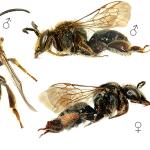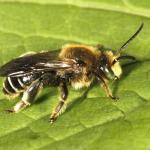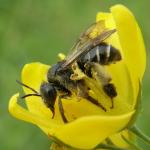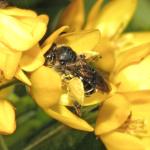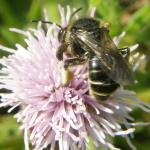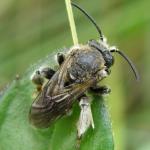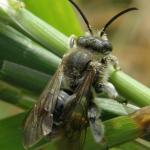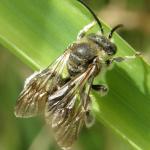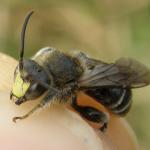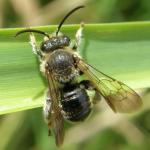Megilla labiata auct., nec FABRICIUS 1804; Andrena lagopus LATREILLE 1809
Of the three species of Macropis which occur in western Europe, only one, M. europaea, is found in Britain. This species is unique in this country for having females which provision their nests with fatty floral oils, in addition to pollen.
Southern England, from Devon to Kent, northwards to Somerset and Norfolk. Very local but often common where it does occur. This species ranges from southern Fennoscandia south to central Spain, and eastwards to Kazakhstan; there is a single record from North Africa (Algeria) (Vogel 1986).
Listed as Rare (RDB3) in Shirt (1987), and as Nationally Notable (Na) in Falk (1991). Work for this Atlas suggests that its status should be reviewed.
Wetland sites supporting the main forage plant, yellow loosestrife (Lysimachia vulgaris). Hence this bee is to be found in fens, bogs and alongside rivers and canals.
Univoltine; mid July to early September, the flight period being very closely synchronised with the flowering of the main host plant.
Nest burrows are excavated in the soil, generally in banks or slopes. The burrow entrances are usually well concealed by overhanging vegetation and are thus rarely observed Nests normally occur in loose aggregations (M Edwards and S Falk, pers. comm.). Nests have been described by both Malyshev (1929) and Phipps (1948) (both as M. labiata). These authors noted that the cells were lined with a yellowish wax-like, waterproof substance which may have been derived from yellow loosestrife floral oil. Larvae and pupae have been described by Rozen & McGinley (1974).
In addition to the forage species listed above, the bee has been observed visiting (as nectar sources) bird's-foot-trefoil (Lotus corniculatus), bramble (Rubus fruticosus agg.), tormentil (Potentilla erecta), agrimony (Agrimonia sp.), great willowherb (Epilobium hirsutum), hogweed (Heracleum sphondylium), mint (Mentha sp.), yarrow (Achillea millefolium), creeping thistle (Cirsium arvense), knapweed (Centaurea sp.), rough hawkbit (Leontodon hispidum), sow-thistle (Sonchus sp.), water chickweed (Myosoton aquaticum) and water-plantain (Alisma lanceolata).
None reported from Britain. On the Continent the anthophorine bee Epeoloides coecutiens is a cleptoparasite of this species, but it is not known from Britain.
Profile written: 1998
Proofed: January 2012


